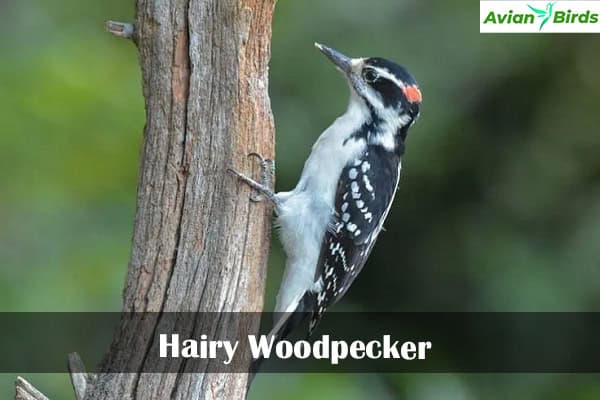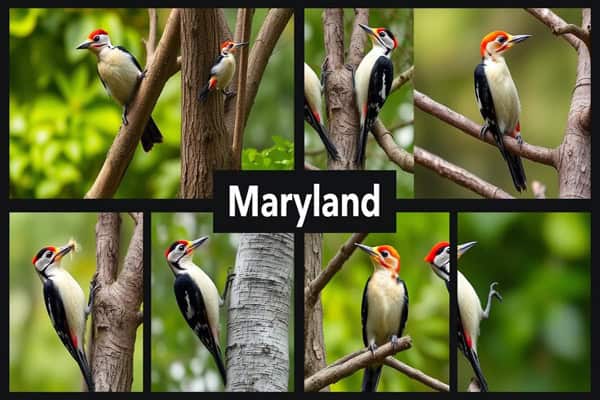Woodpeckers in Maryland (7 Common Species & ID Guide)
Did you know woodpeckers in Maryland can drum at 20 hits per second? This amazing skill is not just fun for bird lovers. It helps them talk, mark their territory, and find food. If you love bird-watching in Maryland, you’re in for a treat!
Maryland has seven common woodpecker species. Each one is special and adds to the state’s beauty. You’ll learn about their looks, where they live, and how they act. Woodpeckers are known for their loud calls and drumming. These sounds are important in the forest and make bird watching even better.
Introduction to Woodpeckers
Woodpeckers are fascinating birds that capture the attention of birdwatching enthusiasts. They have unique behaviors and striking appearances. Their strong beaks help them thrive in their environments.
Woodpeckers have zygodactyl feet, which grip tree trunks firmly. They forage for insects hidden beneath the bark. Their typical habitat is forests, where they create nesting cavities. These cavities benefit other species once abandoned.
Overview of Woodpecker Characteristics
The behavior of woodpeckers is intriguing. Their drumming calls serve multiple purposes. They attract mates and mark territory.
In Maryland, seven common woodpecker species can be observed. The Red-bellied Woodpecker is about 9.25 inches long with a 16-inch wingspan. The Pileated Woodpecker is larger, measuring 16.5 inches long and having a 29-inch wingspan.
These traits help identify woodpecker species and enhance birdwatching. Knowing their sizes and markings aids in accurate identification. The Downy Woodpecker, for example, is small but charming.
Engaging in birdwatching during their active times reveals their interesting behaviors and habits.
Woodpecker Habitat in Maryland
Maryland has many places where woodpeckers can live. Forests, parks, and even city green spaces help these birds. Hardwood forests and mixed woodlands are great for them. These places offer homes and food, like insects.
The Zekiah Swamp Important Bird Area (IBA) is a special place. It has over 15,088 acres of forests and wetlands. Most of it is deciduous floodplain forest and upland oak-hickory forest. It’s home to the Red-headed Woodpecker, which likes to nest in dead trees.
But, woodpeckers face dangers. Development, logging, and pests like the emerald ash borer harm their homes. We need to work to protect these birds and their places.
When you visit Maryland, look for the woodpeckers. Knowing where they live helps us care for them. It’s important for their survival.
Woodpeckers in Maryland
Maryland is home to many woodpeckers. You can find them in different places. There are seven main types, each with its own special features. Knowing about these birds can make birdwatching more fun.
Overview of Common Species
In Maryland, you’ll find woodpeckers from small to big. Here’s a quick look at them:
- Downy Woodpecker: The smallest, like a house sparrow. Males have a red spot on their neck.
- Hairy Woodpecker: A bit bigger, like an eastern chipmunk.
- Northern Flicker: Bigger than a blue jay. It’s very loud, especially the yellow-shafted ones.
- Red-bellied Woodpecker: The same size as Hairy and Blue Jay. It likes old oak and hickory trees.
- Yellow-bellied Sapsucker: Bigger than Downy. It looks like Hairy Woodpecker.
- Red-headed Woodpecker: Known for its bright red head and bicolored back. It’s like Hairy Woodpecker in size.
- Pileated Woodpecker: The biggest in Maryland. It’s as big as a crow and has a red crown.
Importance of Woodpeckers in Ecosystems
Woodpeckers do more than look good. Also, They help keep Maryland’s forests healthy. They eat insects, protecting trees from harm.
They also make homes for other birds. This helps forests have more life. Watching them shows how important they are to our environment.
| Woodpecker Species | Size Comparison | Distinctive Features |
|---|---|---|
| Downy Woodpecker | Similar to a house sparrow | Male has a red nape blotch |
| Hairy Woodpecker | Twice the size of a downy | Similar patterns to Downy, larger |
| Northern Flicker | Slightly larger than a blue jay | Very vocal, yellow-shafted variety |
| Red-bellied Woodpecker | Similar to Hairy and Blue Jay | Common in oak and hickory stands |
| Yellow-bellied Sapsucker | Larger than a Downy | Holes in trees for sap feeding |
| Red-headed Woodpecker | Similar in size to Hairy | Bright red head, bicolored back |
| Pileated Woodpecker | Roughly the size of a crow | Prominent red crown |
1. Downy Woodpecker
- Scientific Name: Picoides pubescens
- Size: 14–19 cm (5.5–7.5 in)
- Weight: 28–90 g (1–3.2 oz)
- Lifespan: Up to 10 years in the wild
- Diet: Insects, larvae, seeds, and berries.
The Downy Woodpecker is a small bird found in Maryland. It is between the size of a sparrow and a robin. It has black and white feathers, with a white back and small black spots on its tail.

Male birds have a small red patch on their neck. This makes them easy to spot.
These woodpeckers live in Maryland all year. They like open woodlands with trees that lose their leaves. Parks and backyards are great places to see them.
They make high-pitched sounds and move fast. They look for insects like beetles and ants on trees and shrubs.
Downy Woodpeckers breed in interesting ways. They lay 3 to 8 white eggs. The eggs hatch after 12 days.
Studies show their numbers are steady. So, you can see these birds in many places.
| Characteristic | Details |
|---|---|
| Size | 6-7 inches |
| Plumage | Black and white with a white back |
| Diet | Insects (mainly beetles and ants), berries, grains |
| Breeding | 3-8 white eggs; 12-day incubation |
| Lifespan | Oldest recorded: 11 years |
| Habitat | Deciduous woods, suburban backyards, parks |
| Population Status | Stable across North America |
Watching Downy Woodpeckers is fun. They are easy to see in places where people live. It makes birdwatching more enjoyable.
Must Visit: Woodpeckers in Florida
2. Hairy Woodpecker
- Scientific Name: Picoides villosus
- Size: 20–23 cm (7.9–9.1 in)
- Weight: 70–100 g (2.5–3.5 oz)
- Lifespan: Up to 15 years in the wild
- Diet: Insects, especially wood-boring beetles, along with some seeds and fruits
The Hairy Woodpecker is often confused with the Downy Woodpecker. It’s a bird you can find in wooded areas. It’s bigger than the Downy, measuring 7 to 10 inches long.

Unlike the Downy’s short, tapered bill, its bill is long and straight. The Hairy Woodpecker has a bold black and white body. Males have a red splash on their heads, adding color to their look.
It doesn’t have the small white spots on its tail feathers like the Downy. This helps tell the two woodpeckers apart. Bird watchers can use these clues to identify them.
The Hairy Woodpecker loves mature forests with big trees. It drums loudly to talk and mark its territory. This sound helps you know one is around.
Watch for other birds living in the same places when you’re out. But make sure to tell them apart by looking at their size, bill shape, and sounds.
3. Northern Flicker
- Scientific Name: Colaptes auratus
- Size: 30–36 cm (12–14 in)
- Weight: 90–150 g (3.2–5.3 oz)
- Lifespan: Up to 9 years in the wild
- Diet: Primarily ants and beetles, along with seeds and fruits
The Northern Flicker is easy to spot because of its unique colors and patterns. It has a spotted breast and a black bib. Its tan and brown feathers make it even more special.

This bird is bigger than the Downy and Hairy Woodpeckers. It’s about 12.5 inches long and has a 20-inch wingspan. It weighs around five ounces, making it sturdy.
Look for yellow underwings on the eastern yellow-shafted subspecies in Maryland. You’ll hear their loud calls and drumming in spring. This is how males show their territory or find mates.
These woodpeckers are great at finding ants by digging in the ground. They sometimes live in old burrows left by Belted Kingfishers or Bank Swallows. You can see them all year, especially with trees and open spaces.
What makes the sound of Northern Flicker?
Must Read: Woodpeckers in Arkansas
4. Red-bellied Woodpecker
- Scientific Name: Melanerpes carolinus
- Size: 23–25 cm (9–10 in)
- Weight: 70–100 g (2.5–3.5 oz)
- Lifespan: Up to 12 years in the wild
- Diet: Insects, fruits, nuts, and seeds
The Red-bellied Woodpecker is a joy to see in Maryland. It has black and white bars on its back. It’s bigger than a robin but smaller than a crow.
Its belly has a reddish patch, but it’s not always easy to see. This bird weighs about 3 ounces. It has a wingspan of 13 to 16.5 inches.

This bird is easy to spot because of its size and markings. They like to tap on trees looking for food. Their diet includes insects, nuts, and seeds.
They are very good at finding food in different places. This shows how well they can adapt.
Nesting is a key part of their life. Males dig holes in dead trees for nests. They lay 2 to 6 eggs at a time.
The number of eggs can change based on where they live. In the north, they have one brood a year. In the south, they might have up to three.
This affects how many of them there are in an area. Over time, their numbers have stayed pretty steady. They have grown a bit as they move north.
There are about 16 million of them worldwide. From 1966 to 2019, their numbers grew by 0.8% each year. This means they don’t need a lot of help from us to survive.
The call of Rad Bellied Woodpecker
Also read: Woodpeckers in Wisconsin
5. Yellow-bellied Sapsucker
- Scientific Name: Sphyrapicus varius
- Size: 18–22 cm (7–8.7 in)
- Weight: 50–100 g (1.8–3.5 oz)
- Lifespan: Up to 6 years in the wild
- Diet: Primarily sap from trees, along with insects and fruits
The Yellow-bellied Sapsucker is a bird that stands out. It’s about 8.5 inches long. Its black and white feathers and red crown make it easy to spot. Males have a red throat, making them even more unique.
This bird is special because of how it eats. Unlike many birds, it drills holes in trees. These holes are a key part of how it finds food, especially in spring.

Yellow-bellied Sapsuckers migrate to the eastern U.S. in winter. They live in Canada and some northern states during breeding season. They also live in the Appalachian Mountains, including Garrett County, Maryland.
You can find these birds in forests, especially in areas with birch or maple trees. Their drilling sounds and calls are easy to recognize. This means they might be nearby.
| Characteristic | Description |
|---|---|
| Size | Approximately 8.5 inches in length |
| Coloration | Black and white with a red crown; males have red throats |
| Feeding Behavior | Creates horizontal rows of holes in trees for sap extraction |
| Migration | Winters in the eastern U.S.; breeds in Canada and northern states |
| Nesting Preference | Nests in groves of small trees like aspens |
6. Red-headed Woodpecker
- Scientific Name: Melanerpes erythrocephalus
- Size: 22–26 cm (8.7–10.2 in)
- Weight: 70–100 g (2.5–3.5 oz)
- Lifespan: Up to 9 years in the wild
- Diet: Insects, fruits, nuts, and seeds, often foraging on the ground
The Red-headed Woodpecker is a beautiful bird. It has a bright red head and black and white body. This makes it easy to spot.

These birds are very agile when they hunt. They like open woodlands, not cities. Sadly, their numbers are going down a lot.
- Estimated global breeding population: 1.8 million
- Continental Concern Score: 13 out of 20
- Decline rates: over 1% per year
Long ago, people even paid for these birds. Now, we need to help them. We can do this by keeping dead trees for them.
Knowing about the Red-headed Woodpecker helps us protect it. We can support efforts to save this special bird.
Make the sound of Rad headed Woodpecker?
Also Visit: Woodpeckers in Texas
7. Pileated Woodpecker
- Scientific Name: Dryocopus pileatus
- Size: 38–49 cm (15–19 in)
- Weight: 250–400 g (8.8–14.1 oz)
- Lifespan: Up to 12 years in the wild
- Diet: Primarily wood-boring insects, including beetle larvae, as well as fruits and nuts
The Pileated Woodpeckers of Maryland is a striking bird. It is the largest woodpecker in Maryland, growing from 16 to 19 inches. Its wingspan and bold black plumage make it stand out in forests.

Look for the vibrant red crest and white striped neck to identify it. These traits make it a favorite among bird watchers.
Pileated Woodpeckers use their strong beaks to dig large cavities. They search for wood-boring beetles and other insects. They prefer mature forests with dead trees.
In places like Harford County, Maryland, they play a big role in forest ecology. They create depressions in wood, showing where they forage. This helps spot wood-boring insect pests and tree health issues.
Knowing about Pileated Woodpeckers makes birdwatching more fun. Spotting their size and unique traits helps you appreciate Maryland’s magnificent birds.
What makes the sound of a Pileated Woodpecker?
Read More🐦Related Articles:
| Yellowhammer: Alabama’s Vibrant State Bird |
| Budgerigar: The Perfect Pet Parakeet |
| Top Blue Parrot Species to Keep as Pets |
| Barn Swallow: Everything You Need To Know |
| Doves in Kansas |
Conclusion
Learning about Maryland’s woodpeckers makes birdwatching more fun. It also helps protect these amazing birds. With eight species, like the Red-bellied Woodpecker and Pileated Woodpecker, there’s much to see.
Each woodpecker is special. The Downy Woodpecker drums loudly, and the Yellow-bellied Sapsucker drills into trees for sap. These habits are fascinating.
However, urban growth threatens their homes. We must protect these birds. Conservation helps keep the balance in nature.
Learning to watch birds helps us all. It ensures future generations can see these woodpeckers in the wild. This is very important.
Knowing about laws like the Migratory Bird Treaty Act helps, too. It keeps woodpeckers safe in Maryland. If you have woodpecker problems, find kind solutions.
Working together, we can live with woodpeckers. This makes our forests more diverse and beautiful.







